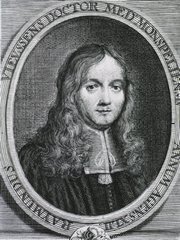This article is part of the series "A Moment in History" where we honor those who have contributed to the growth of medical knowledge in the areas of anatomy, medicine, surgery, and medical research.

Raymond de Vieussens
Raymond de Vieussens (c.1635 – 1715). French anatomist and physician. His exact date and place of birth are uncertain, some place him being born in the area of Le Vigan in France and the date for some authors as late as 1641.
What we do know is that he studied at the University of Montpellier where he graduated from his medical studies in 1670. He became a physician at the Hôtel Dieu Saint-Eloi in Montpellier. He later became head physician at the same hospital and apparently maintained this position for the rest of his life. His studies on the anatomy of the heart and lymphatic system were pioneers for the time, as were his studies on the anatomy of the nervous system.
Vieussens was a prolific writer. Among his works in 1706, he published “Nouvelles Découvertes sur le Coeur” (New Discoveries on the Heart) followed by “Traité Nouveau de la Structure et Des causes du Mouvement Naturel du Coeur” (New Treaties on the Structure and Cause of the Natural Movement of the Heart) in 1715. In these books he presented detailed anatomy of the lymphatic system and blood vessels of the heart, as well as his theories on the movement of the heart. In his work, he did the first accurate description of mitral stenosis and aortic disease.
One of his greatest works was “Neurographia Universalis”, published in 1684 in Lyons, France. In this book Vieussens describes the structure of the nervous system with emphasis on the pathways of the white substance, which we know today is formed by bundles of neuronal axons. He accurately described the internal structure of the cerebellum and other structures that today bear his name. Unfortunately Vieussens attempted to describe the physiology of the brain with little factual support, developing wild theories, including the statement that he had found the “fluid of the nerves”.
Some of Vieussens’ work was published posthumously by his family and colleagues. Today, many eponyms remember Vieussens’ name, here are some of them:
- Valve of Vieussens: A valve found at the distal end of the great cardiac vein, where it empties into the coronary sinus
- Ring of Vieussens: Name for and anatomical variation in the heart, an anastomotic communication between two conal arteries, one arising from the right coronary artery, the other arising from the left anterior descending artery (LAD)
- Centrum of Vieussens: A term that describes the mass of white matter at the center of each cerebral hemisphere
- Ring of Vieussens: Eponymic term for the limbus fossa ovalis, a raised muscular ring surrounding the fossa ovalis in the heart
- Valve of Vieussens: A thin veil of tissue between the superior cerebellar peduncles, forming part of the roof of the 4th ventricle. This is known as the superior medullary vellum and may have some sparse cerebellar tissue on it
- The ventricle of Vieussens: The name of a cavity found in the case where the septum pellucidum is double. The septum pellucidum is a membrane that separates the lateral ventricles of the brain in the midline
If you hover with your mouse over the image of young Vieussens you will see another image of Vieussens at 65.
Original images courtesy of National Library of Medicine.



